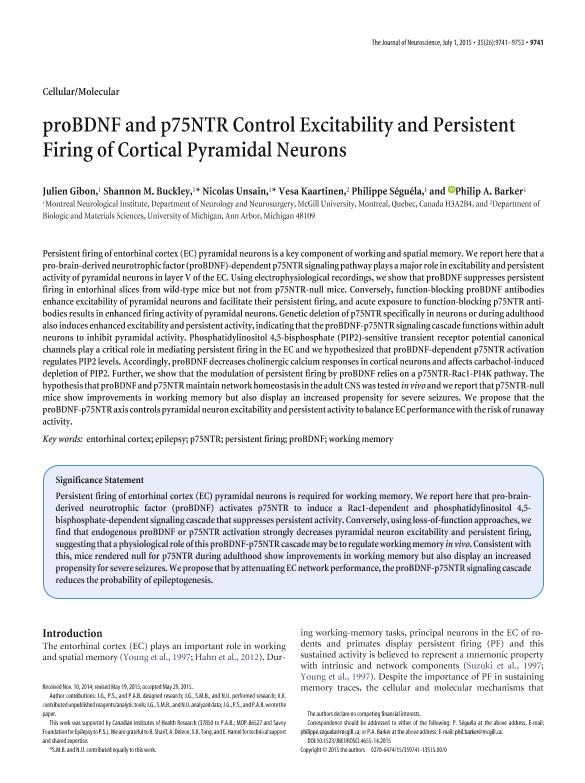Mostrar el registro sencillo del ítem
dc.contributor.author
Gibon, Julien
dc.contributor.author
Buckley, Shannon M.
dc.contributor.author
Unsain, Nicolas

dc.contributor.author
Kaartinen, Vesa
dc.contributor.author
Séguéla, Philippe
dc.contributor.author
Barker, Philip A.
dc.date.available
2019-02-05T14:57:09Z
dc.date.issued
2015-07
dc.identifier.citation
Gibon, Julien; Buckley, Shannon M.; Unsain, Nicolas; Kaartinen, Vesa; Séguéla, Philippe; et al.; proBDNF and p75NTR control excitability and persistent firing of cortical pyramidal neurons; Society for Neuroscience; Journal of Neuroscience; 35; 26; 7-2015; 9741-9753
dc.identifier.issn
0270-6474
dc.identifier.uri
http://hdl.handle.net/11336/69397
dc.description.abstract
Persistent firing of entorhinal cortex (EC) pyramidal neurons is a key component of working and spatial memory. We report here that a pro-brain-derived neurotrophic factor (proBDNF)-dependent p75NTR signaling pathway plays a major role in excitability and persistent activity of pyramidal neurons in layer V of the EC. Using electrophysiological recordings, we show that proBDNF suppresses persistent firing in entorhinal slices from wild-type mice but not from p75NTR-null mice. Conversely, function-blocking proBDNF antibodies enhance excitability of pyramidal neurons and facilitate their persistent firing, and acute exposure to function-blocking p75NTR antibodies results in enhanced firing activity of pyramidal neurons. Genetic deletion of p75NTR specifically in neurons or during adulthood also induces enhanced excitability and persistent activity, indicating that the proBDNF-p75NTR signaling cascade functions within adult neurons to inhibit pyramidal activity. Phosphatidylinositol 4,5-bisphosphate (PIP2)-sensitive transient receptor potential canonical channels play a critical role in mediating persistent firing in the EC and we hypothesized that proBDNF-dependent p75NTR activation regulates PIP2 levels. Accordingly, proBDNF decreases cholinergic calcium responses in cortical neurons and affects carbachol-induced depletion of PIP2. Further, we show that the modulation of persistent firing by proBDNF relies on a p75NTR-Rac1-PI4K pathway. The hypothesis that proBDNF and p75NTR maintain network homeostasis in the adult CNS was tested in vivo and we report that p75NTR-null mice show improvements in working memory but also display an increased propensity for severe seizures. We propose that the proBDNF-p75NTR axis controls pyramidal neuron excitability and persistent activity to balance EC performance with the risk of runaway activity.
dc.format
application/pdf
dc.language.iso
eng
dc.publisher
Society for Neuroscience

dc.rights
info:eu-repo/semantics/openAccess
dc.rights.uri
https://creativecommons.org/licenses/by-nc-sa/2.5/ar/
dc.subject
Entorhinal Cortex
dc.subject
Epilepsy
dc.subject
P75ntr
dc.subject
Persistent Firing
dc.subject
Probdnf
dc.subject
Working Memory
dc.subject.classification
Otras Ciencias Biológicas

dc.subject.classification
Ciencias Biológicas

dc.subject.classification
CIENCIAS NATURALES Y EXACTAS

dc.title
proBDNF and p75NTR control excitability and persistent firing of cortical pyramidal neurons
dc.type
info:eu-repo/semantics/article
dc.type
info:ar-repo/semantics/artículo
dc.type
info:eu-repo/semantics/publishedVersion
dc.date.updated
2019-02-04T13:08:42Z
dc.journal.volume
35
dc.journal.number
26
dc.journal.pagination
9741-9753
dc.journal.pais
Estados Unidos

dc.journal.ciudad
Washington
dc.description.fil
Fil: Gibon, Julien. McGill University; Canadá
dc.description.fil
Fil: Buckley, Shannon M.. McGill University; Canadá
dc.description.fil
Fil: Unsain, Nicolas. Consejo Nacional de Investigaciones Científicas y Técnicas; Argentina. McGill University; Canadá
dc.description.fil
Fil: Kaartinen, Vesa. University of Michigan; Estados Unidos
dc.description.fil
Fil: Séguéla, Philippe. McGill University; Canadá
dc.description.fil
Fil: Barker, Philip A.. McGill University; Canadá
dc.journal.title
Journal of Neuroscience

dc.relation.alternativeid
info:eu-repo/semantics/altIdentifier/doi/https://dx.doi.org/10.1523/JNEUROSCI.4655-14.2015
dc.relation.alternativeid
info:eu-repo/semantics/altIdentifier/url/http://www.jneurosci.org/content/35/26/9741
Archivos asociados
